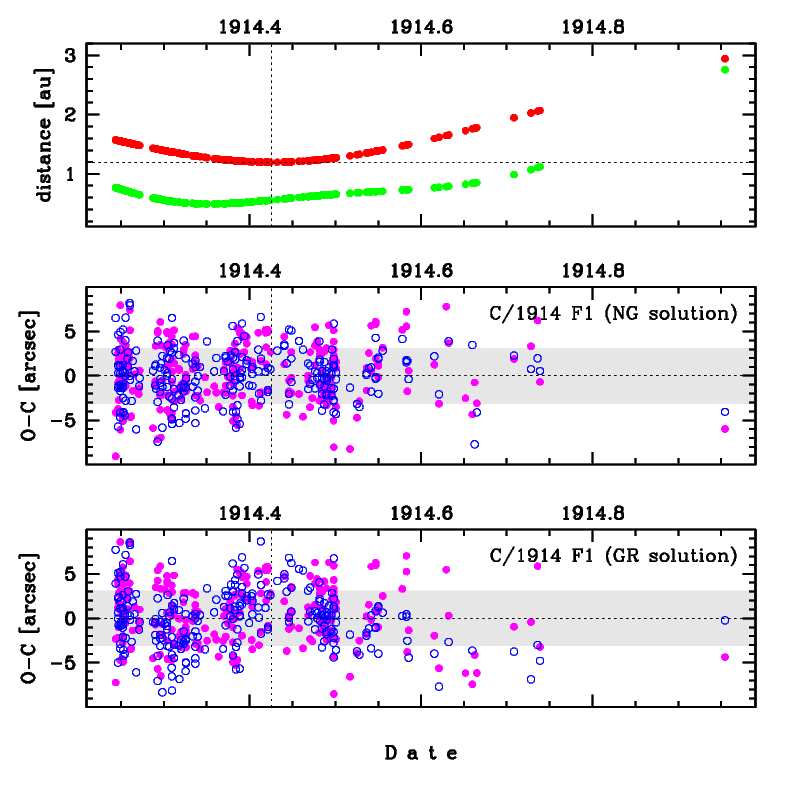C/1914 F1 Kritzinger
more info
Comet C/1914 F1 was discovered on 30 March 1914 by Hans Hermann Kritzinger (Bothkamp, Germany), Kronk raported about a prediscovery position taken on 24 March. At the moment of discovery C/1914 F1 was about two months before its perihelion passage, and it was last seen on 14 December 1914. [Kronk, Cometography: Volume 3].
This comet made its closest approach to the Earth on 9 May 1914 (0.495 au), that is almost six weeks after its discovery and almost four weeks before perihelion.
Solutions given here are based on data spanning over 0.707 yr in a range of heliocentric distances from 1.57 au through perihelion (1.20 au) to 2.94 au.
Pure gravitational orbit determined from all available positional measurements (285 observations) give 2a-class orbit, orbit given in Minor Planet Center is 2A class (62 obs. used, almost three months shorter arc of data; see MPC).
It was possible to determine the non-gravitational orbit for C/1914 F1 (preffered orbit), the RMS for NG orbit decreases (from 3.33 arcsec to 3.12 arcs) and some trends in O-C disappears (see figure). According to this model original semimajor axis of C/2014 F1 is about 1670 au.
This comet suffers significant planetary perturbations during its passage through the planetary system that lead to a more tight future orbit with semimajor axis of about 700 au (see future barycentric orbits given here for both solutions: pure gravitational and non-gravitational).
More details in Królikowska et al. 2014.
This comet made its closest approach to the Earth on 9 May 1914 (0.495 au), that is almost six weeks after its discovery and almost four weeks before perihelion.
Solutions given here are based on data spanning over 0.707 yr in a range of heliocentric distances from 1.57 au through perihelion (1.20 au) to 2.94 au.
Pure gravitational orbit determined from all available positional measurements (285 observations) give 2a-class orbit, orbit given in Minor Planet Center is 2A class (62 obs. used, almost three months shorter arc of data; see MPC).
It was possible to determine the non-gravitational orbit for C/1914 F1 (preffered orbit), the RMS for NG orbit decreases (from 3.33 arcsec to 3.12 arcs) and some trends in O-C disappears (see figure). According to this model original semimajor axis of C/2014 F1 is about 1670 au.
This comet suffers significant planetary perturbations during its passage through the planetary system that lead to a more tight future orbit with semimajor axis of about 700 au (see future barycentric orbits given here for both solutions: pure gravitational and non-gravitational).
More details in Królikowska et al. 2014.
| solution description | ||
|---|---|---|
| number of observations | 285 | |
| data interval | 1914 03 30 – 1914 12 14 | |
| data type | perihelion within the observation arc (FULL) | |
| data arc selection | entire data set (STD) | |
| range of heliocentric distances | 1.57 au – 1.20 au (perihelion) – 2.94 au | |
| detectability of NG effects in the comet's motion | comet with determinable NG~orbit | |
| type of model of motion | GR - gravitational orbit | |
| data weighting | YES | |
| number of residuals | 517 | |
| RMS [arcseconds] | 3.33 | |
| orbit quality class | 2a | |
| orbital elements (heliocentric ecliptic J2000) | ||
|---|---|---|
| Epoch | 1914 05 28 | |
| perihelion date | 1914 06 04.69315787 | ± 0.00025600 |
| perihelion distance [au] | 1.19853665 | ± 0.00000529 |
| eccentricity | 1.00018867 | ± 0.00003381 |
| argument of perihelion [°] | 72.224168 | ± 0.000277 |
| ascending node [°] | 200.117415 | ± 0.000322 |
| inclination [°] | 23.914811 | ± 0.000339 |
| reciprocal semi-major axis [10-6 au-1] | -157.41 | ± 28.21 |

Upper panel: Time distribution of positional observations with corresponding heliocentric (red curve) and geocentric (green curve) distance at which they were taken. The horizontal dotted line shows the perihelion distance for a given comet whereas vertical dotted line — the moment of perihelion passage.
Lower panel (panels): O-C diagram for this(two) solution (solutions) given in this database, where residuals in right ascension are shown using magenta dots and in declination by blue open circles.
Lower panel (panels): O-C diagram for this(two) solution (solutions) given in this database, where residuals in right ascension are shown using magenta dots and in declination by blue open circles.